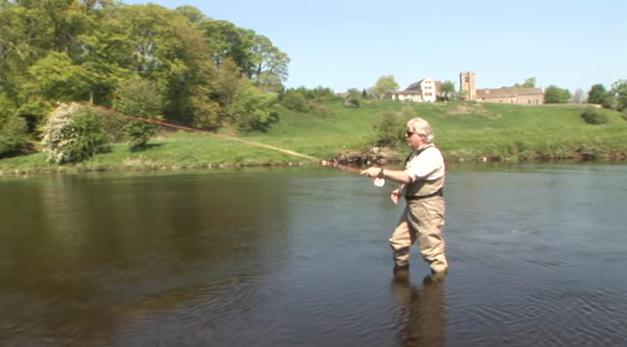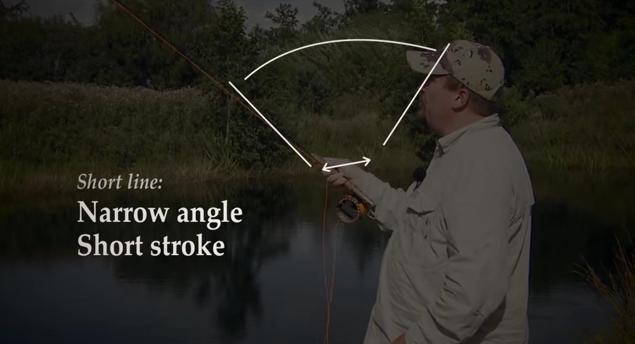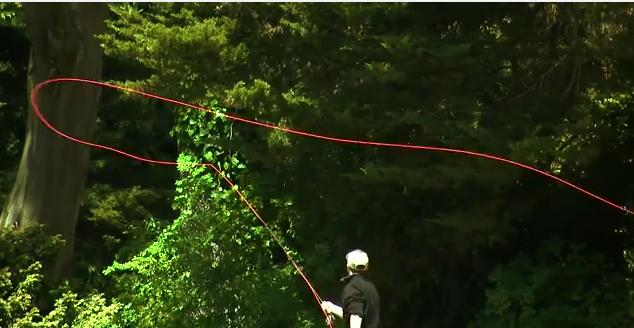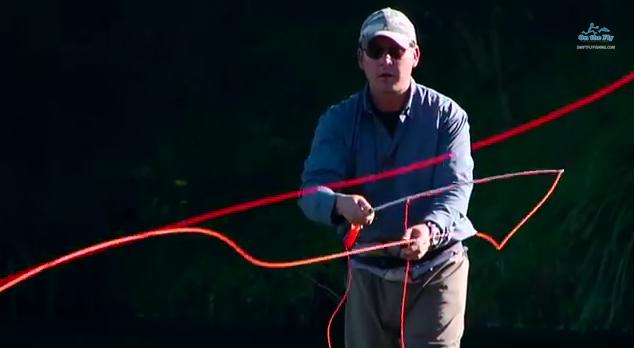| Disclosure: Just to be open and honest the buttons and links you click on in the website will in most cases take you to another website where you can purchase the products I am reviewing. As an Amazon Associate I earn from qualifying purchases. |
Fly Fishing Casting Basics – What to get Right from the Beginning
When people look at a skilled fly fishing angler they are usually amazed at how they are able to manipulate the fly line into tight loops and cast flies across a stretch of water to feeding fish.
Most are put off learning the sport for fear of it being too hard to learn, others are excited by the challenge and there are all those in between.
I can tell you that fly fishing casting basics are in no way difficult, what they do require is practice and depending on your hand-eye coordination that amount of practice will be different for everyone.
It’s no different to any sport the more you put in the better you will become and the more you will get back from the sport.
With that being said it doesn’t mean you need to give hours each day to it. In fact, once you learn the casting basics you can keep up your skills by simply getting out and fly fishing.
The art of casting a fly is fairly basic the rod is used to throw the fly line, leader and fly to and fro behind and in front of you.
To do this you first need to load the fly rod to make it flex so there is enough energy to throw the line from behind to out in front again.
This is an arc motion of the rod which comes in three stages. The lift, the pause and the forward cast.
The lift, is when the fly line is lifted from the water with the fly rod in a sweeping motion accelerating from 4 o’clock to a full stop at 11 o’clock.
To perform this effectively you need to do it in a smooth one-motion movement where the stop at the top is solid.
The solid stop allows the fly line to shoot behind you and the rod tip in the air until it reaches its full length.
This will be dependent on how much line you have out for that cast.
This is when the pause is played.
As you need to allow the line to flow behind you until it pulls your rod tip backward as it re-loads the rod ready for the forward stroke.
The timing here comes with practice but allowing the line to fully extend behind you and load the rod makes the forward stroke so much easier.
The forward stroke then comes back from 11 o’clock to 2 o’clock again with a swift stop.
The action is accelerated from the 11 position to the 2 position with a full stop at this point.
The stop allows the forward motion of the fly line to unfurl out in front of you at height before gently floating down to the water surface.
It’s the mastering of this that allows experienced anglers to catch timid trout and other species with delicate casting of flies into their eye sight.
Tips on how to get the timing of the cast
1) Start off on grass a nicely cut lawn or sports pitch is ideal as the grass will be short and not tangle the fly line.
Don’t connect a fly to your leader at this point but a piece of colored wool about 1-2 inches in length.
This acts as a visual guide to show you where your fly is landing and how well it is presented.
Only use one piece at the end of the leader at this stage there is no need for a leader tied with two or three simulated flies at this point.
That we will save for the water when we are actually fishing.
2) Don’t try to cast too much line at first but grow into the cast as you master the action required.
I’m saying not too much but we do need to load the rod so that will take about 10-15ft of fly line plus leader to do so.
3) Think of yourself using a hammer and banging a nail into a wall in front of you.
Without taking the rod to the side lift it to the 11pm position over your shoulder keeping your elbow tight to your side making sure to stop at the 11pm position.
4) Then with a small pause probably 1-2 seconds for that amount of line push your arm forward as if hammering that nail on the wall in front of you.
Again keeping the elbow tight at your side. If you can imagine hitting that nail your arm is going to stop abruptly and this will allow the line to fly out in front of you in the forward cast.
This combined motion is called the overhead cast and the most basic in fly fishing.
5) Try not to break your wrist when pulling the rod back on the backward or forward motions but keep it stiff at all times.
This helps load and flex the rod by having a good anchor point.
There you have it the basic overhead cast.
With practice you will be able to do this easily and be able to use more and more line in the cast.
Just be careful not to try and use too much line at the beginning as it will not flow easily through the air and two seconds will not be enough time to fully extend it behind you.
The loop will collapse and you will get frustrated. So start with small casts concentrating on the timing and the feel of the cast.
Check out Mike Roden’s video here below for the full demonstration plus what not to do tips.
Fly fishing is a beautiful and engaging sport that relies on precise casting techniques to present artificial flies to fish in a natural and enticing manner. If you’re just starting with fly fishing, mastering the basics of fly casting is essential. Here’s what to do right from the start:
- Select the Right Gear:
- Fly Rod: Choose an appropriate fly rod for the type of fishing you plan to do. Rods are designed for specific line weights, so make sure your rod matches the line weight recommended for the species you’re targeting.
- Fly Reel: Match your reel to your rod and line. The reel should have enough capacity for the specific line you’re using.
- Fly Line: Different lines are designed for various casting and fishing situations. A weight-forward (WF) line is a good choice for beginners as it’s versatile and easier to cast.
- Leaders and Tippet: Leaders and tippet material are used to connect the fly to the fly line. The length and strength of your leader and tippet depend on the fishing conditions and the size of the flies you’re using.
- Learn the Basic Casting Techniques:
- Grip: Hold the fly rod with a relaxed grip. Place the cork handle between your thumb and index finger, allowing the rod to pivot.
- Stance: Stand with your feet shoulder-width apart, facing your target. Keep your body relaxed and balanced.
- Back Cast: Begin by raising the rod tip to about eye level and moving it smoothly behind you. The line should form a loop in the air.
- Forward Cast: After your back cast, bring the rod forward, stopping it abruptly when the rod tip is at eye level. The line will unroll and carry the fly to the target.
- Practice Your Timing and Rhythm:
- Casting in fly fishing is all about timing and rhythm. The back cast and forward cast should flow smoothly into each other.
- Start with short casts and gradually increase the distance as you become more proficient. Focus on accuracy rather than distance at first.
- Learn to False Cast:
- False casting involves making several back-and-forth casts without the fly touching the water. It allows you to change direction, lengthen or shorten your line, and dry your fly.
- Avoid excessive false casting, as it can spook fish. Make only as many false casts as necessary.
- Work on Line Control:
- Mend the line: In moving water, use mends to control the position of your line and fly so that it drifts naturally with the current.
- Roll cast: This cast is useful for situations where you can’t make a traditional back cast. It’s a great technique for tight spots or when there’s brush behind you.
- Learn Different Casting Styles:
- There are various casting styles in fly fishing, including overhead casts, sidearm casts, and roll casts. Learning different styles will make you more adaptable to various fishing situations.
- Practice, Practice, Practice:
- The key to becoming a proficient fly caster is practice. Spend time on the water or in your backyard perfecting your casting technique.
- Take Lessons:
- Consider taking lessons from a certified fly casting instructor. They can provide personalized feedback and help you correct any bad habits.
Remember, fly casting takes time to master, so be patient with yourself and enjoy the learning process. Over time, your casting skills will improve, and you’ll have more success on the water.





Nice article Mark.
I have cast a line before, it was tricky to get the swing of it so definitely some practice will be key. It was fun doing it though and I got it going reasonably well following a fair bit of trial and error after numerous efforts. I had an experienced fishing friend with me though giving me tips which of course helped a lot.
Some really nice tips here and well explained. Easy to understand and follow.
Hey Colm, thanks for stopping by, yea practice is the key to all sports even more so with fly fishing. The mechanics are not that difficult its more about the timing. get the timing correct and you will go far.
Also newbies usually try too much power which over loads the rod creating trailing loops and cast breakdowns. It is much easier to cast a fly with a gentle forward stroke as long as the stop position is made properly.
Its the stop that forms the loop at as the fly line coils out over the water, the better the stop the better the loop and the more distance you will get. 🙂